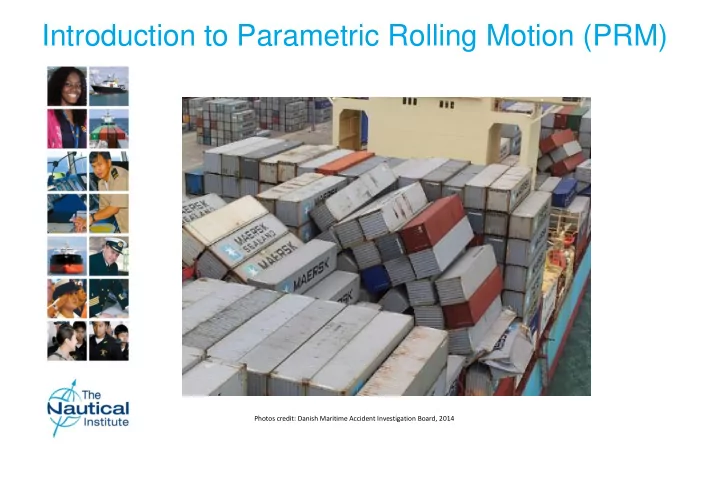

Introduction to Parametric Rolling Motion (PRM) Photos credit: Danish Maritime Accident Investigation Board, 2014
Parametric Rolling Motion (PRM)? • A phenomenon that particularly affects larger vessels with flared fore and aft decks such as Container ships and Pure Car/ Truck Carriers (PCTC)
Parametric Rolling Motion (PRM) • Phenomenon caused by wave-hull interaction a) Head/ bow, following/ quartering seas change water plane (as wave passes through the vessel) resulting in submerged hull geometry change relative to time b) Change in submerged hull geometry leads to change in buoyancy c) Leads to altered stability d) Especially prominent when either the crest or trough is amidships Diagram above shows how change in water plane affects the buoyancy available to the vessel (Sjule, 2016)
Effects of Parametric Rolling Motion (PRM) • Unsafe and unpleasant to crew • Lead to sudden severe rolling motion • Angle of rolling can be up to 40⁰ • Containers and lashing are placed under extreme stress • Potentially exposing vessel’s propulsion system to varying load • Can lead to capsizing of the vessel
Svendborg Maersk case study Danish Maritime Accident Investigation Board, 2014 On 14 th Feb 2014, Svendborg Maersk was sailing under heavy weather: 1. 1420 the master reduced speed and changed heading into the wind and sea to minimise rolling. 2. 1643 without any warning, the vessel suddenly rolled to extreme angles of 38° three to four times. 3. 1913 the vessel experienced rolling over 41°
Svendborg Maersk case study Danish Maritime Accident Investigation Board, 2014 4. Both rolling motions were short lived but caused failure of equipment and loss of cargo 5. Investigation revealed that PRM caused over 600 damaged containers, more that 500 containers lost at sea along with damage to other equipment
Svendborg Maersk case study Danish Maritime Accident Investigation Board, 2014 1. The case study showed that the master unknowingly exposed the vessel to conditions that led to PRM; 2. Both incidents of PRM came without warning and were short lived.
Svendborg Maersk case study Danish Maritime Accident Investigation Board, 2014 3. Both PRM instances caused extreme rolling angle of over 35 ⁰ 4. Caused lost and damage to cargo and equipment Bays with lost containers in red (Danish Maritime Accident Investigation Board, 2014)
Detecting inducing factors of PRM PRM occurs when the following factors accumulate: 1. Wave direction (Head, bow, following or quartering sea) 2. Wave length 0.5-1.0 x Vessel's length 3. Changes in stability when waves (crest and trough) affect the vessel due to change to water plane and buoyancy available to vessel 4. Vessel’s speed (corresponding to the encounter period T E of vessel) The diagram above show the ‘Dangerous Zone’ where vessel is at higher risk of being exposed to PRM (IMO, 2007)
PRM inducing factor measurement Mariners should avoid situations where: • Encounter period (T E ) is close to one or half of ship roll period (T R ) Or: 1 • T E = T R or T E = 2 T R • T E can be found inputting vessel speed (kn), wave period(s), and encounter angle ( α ) into the diagram on the right (IMO, 2007). The diagram above show the ‘Dangerous Zone’ where vessel is at higher risk of being exposed to PRM (IMO, 2007)
Avoiding and Correcting PRM Correcting PRM Avoiding PRM • Crew must remain calm • Keep a good look out for sea- • Change the vessel’s state heading and adjust speed • Adjust vessel’s speed and to bring vessel out of the heading accordingly dangerous zone of • Keep in mind stability of vessel 1 T E = T R or T E = 2 T R (GM), vessel should not be too • tender nor too stiff Deploy roll dampening measures where available
Recommendations • Include Parametric Rolling Motion as part of the recommended list of STCW simulation training • Adapt ship-specific guidelines using direct stability assessment. • Integrate sea-state monitoring to onboard systems to assist mariners with identifying inducing factors of PRM sea-state • In the future possibly include sea state monitoring system in the SOLAS mandatory list of equipment integrated with other ship automation equipment
References 1. Danish Maritime Accident Investigation Board, 2014. Svenborg Maersk Heavy weather damage on 14 February 2014 , Valby: Danish Maritime Accident Investigation Board 2. IMO, 2007. Revised Guidance to the Master for Avoiding Dangerous Situations in Adverse Weather and Sea Conditions , London: International Maritime Organization 3. IMO, 2011. Development of Second Generation Intact Stability Criteria, London: International Maritime Organization 4. Sjule, A. 2016. Evaluation of vulnerability to parametric rolling . Stockholm: KTH Royal Institute of Technology School of Engineering Sciences
The end Thank you for listening
Recommend
More recommend